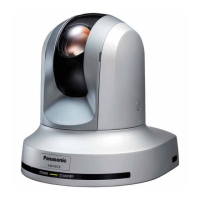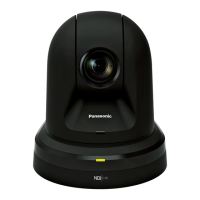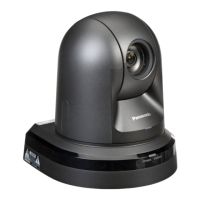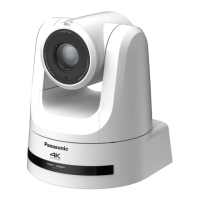67
Controls and settings from web screen
(continued)
R Gain, B Gain [–30 to +30]
When “AWB A”, “AWB B” or “VAR” is selected as the White
Balance Mode setting, the white balance can be finely
adjusted after automatic white balance (AWB) has been
performed.
● When automatic white balance (AWB) is executed,
the R Gain and B Gain values are returned to “0”.
● When “AWB A”, “AWB B” or “VAR” is selected as
the White Balance Mode setting, the R Gain and
B Gain adjustment values can be stored in the three
memories, A, B and VAR.
● When new values are set, the previous values are
erased.
Use each of the memories for a different purpose in
accordance with the shooting conditions.
● R Gain and B Gain adjustments cannot be
performed when [White Balance Mode] is set to
“ATW”, “3200K”, or “5600K”.
Notes
Detail [Off, Low, High]
The image detail (image sharpness) is adjusted here.
When “Low” or “High” is selected, the detail is enhanced.
Detail Level H
[Detail Level L setting +1 to 18]
The image sharpness level is adjusted here when “High”
has been selected as the “Detail” setting.
Detail Level L
[1 to Detail Level H setting –1]
The image sharpness level is adjusted here when “Low”
has been selected as the “Detail” setting.
Flesh Tone Mode [Off, Low, High]
Set here is the flesh tone mode for displaying the subjects’
skin so that it appears more smoothly and eye-pleasingly.
When “Low” or “High” is selected, the effect is enhanced.
HDR [Off, Low, High]
Adjust the effect of the high dynamic range mode.
When HDR is set to “Low”, correction is performed so
that the appropriate exposure is obtained for the light and
dark areas on subjects with extremely high contrast. When
“High” is selected, dark areas are made brighter.
Depending on the shooting conditions, however, the
picture quality may drop with increased noise.
In addition, unit vibration may result in blurry or distorted
images.
This effect is not recommended in shooting locations
where significant vibration may occur.
● When the HDR setting is changed, the image will go
black and the audio will be muted temporarily.
● When “Low” or “High” is selected, it will take longer
for the brightness of the image to converge.
● When “Low” or “High” is selected, brightness cannot
be adjusted.
● When “Low” or “High” is selected, video will be
delayed by 4 frames.
● When “Low” or “High” is selected, the following
settings cannot be changed.
● Day/Night
● Night-Day Level
● Pedestal
● DRS
● Gamma Type
● Back Light COMP.
● Freeze During Preset
● Image Stabilizer
Notes
DNR [Off, Low, High]
Set here is the level of the digital noise reduction effect so
that light, noise-free and clear images will be output even
at night and in other low-brightness environments.
When “Low” or “High” is selected, noise can be eliminated.
However, there is an increased possibility that afterimages
may occur.
Pedestal [–10 to +10]
This item is used to adjust the black level (adjust the
pedestal) so that the dark parts of the images are easier
to see.
These parts become darker when a negative setting is
selected and, conversely, lighter when a positive setting is
selected.
DRS [Off, Low, High]
Set here is the DRS function which provides just the right
amount of compensation when images with significant
light/dark differences are displayed.
When “Low” or “High” is selected, the effect is enhanced
even more.
Depending on the shooting conditions, however, the
picture quality may drop with increased noise.
Gamma Type [Off, Normal, Cinema]
Selected here is the type of gamma curve.
Normally, the “Normal” setting is used.
When “Cinema” is selected, images giving off an
atmosphere like movies can be shot.

